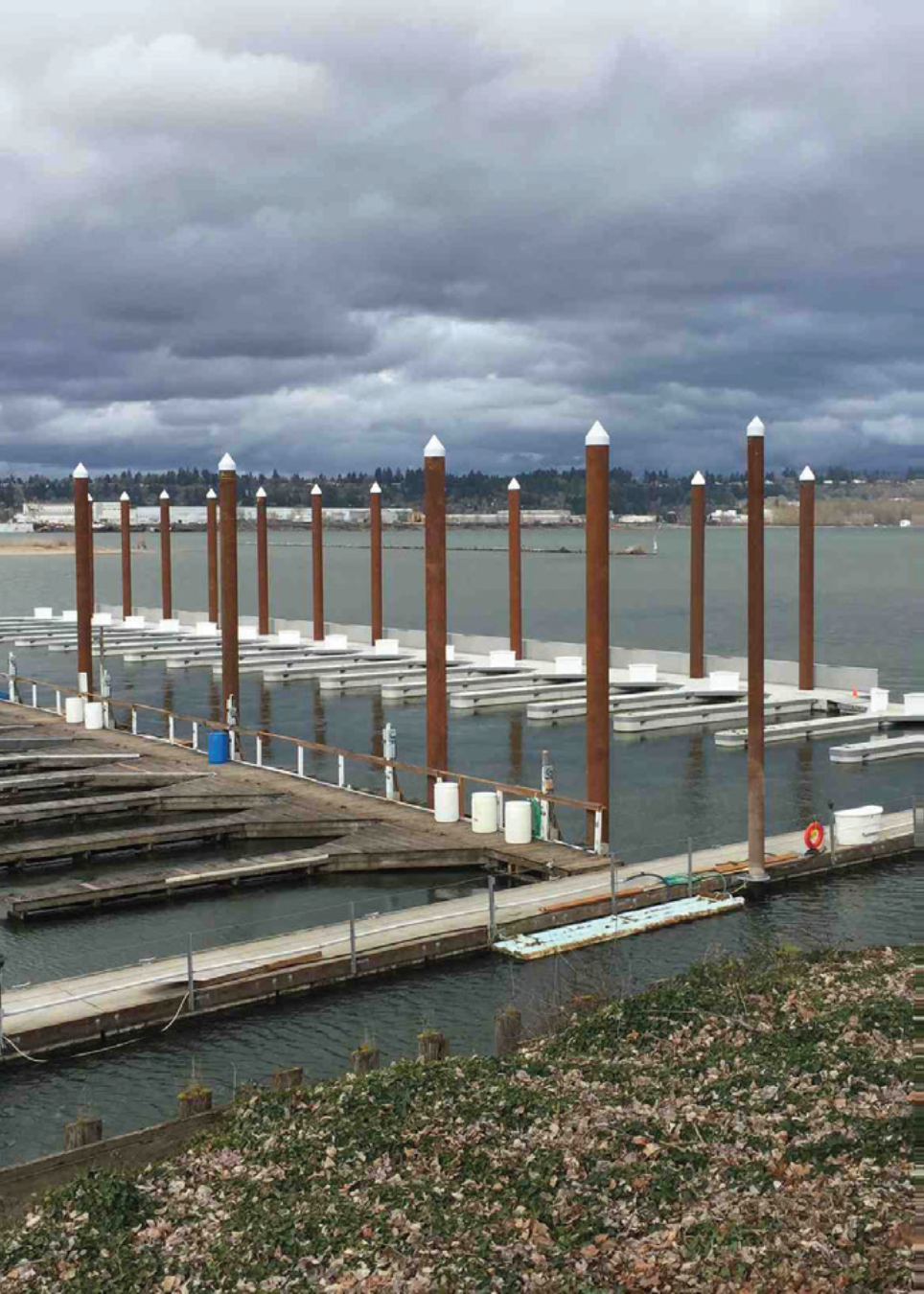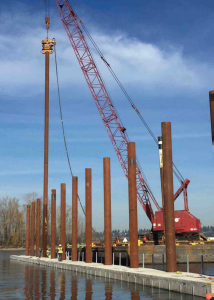
Portland Yacht Club Nears End of Dock Replacement Project
Published on February 24, 2020The Portland Yacht Club (PYC), located on the Columbia River, provides moorage for 200-plus boats, evenly divided between sailboats and powerboats. Back in 2003, PYC embarked on a long-term project to replace the old wooden floating docks at its marina; at the end of 2019 it adopted its final five-year plan, which should complete the replacement of all 15 of its docks by 2024. The first part of that plan includes two new concrete floating docks that Bellingham Marine will be building for PYC this year.
The existing docks have seen decades of service. Founded in 1908, the club moved to its present site in 1922. The club members themselves built the original wooden docks, which floated on logs. Over the next eight decades these docks survived several floods, although one dock broke away in the mid-1980s, and the piling of another actually pulled up off the bottom in 1997. That dock damaged several boats downstream, and the club installed 24-inch batter piles to anchor the row.

Around the turn of the century, PYC members developed a long-range plan of replacing essentially half a mile of marina. “We have 15 rows of docks, and about two-thirds of the moorage is actually boathouses,” said PYC member Frank Borcade. “Some are designed for very large boats, 50 feet and above. They are all at a right angle to one of the most powerful rivers in North America.”
The project, which has been spread out over 20 years to make it affordable for members, provided the club with the opportunity to bring some order to the marina’s layout. Over the decades, whenever docks were needed, members added them wherever seemed most convenient at the time. “There was no rhyme or reason to the plan, particularly the open moorage,” Borcade said.
“We had to do a total redesign of the moorage within the footprint that we had; the footprint couldn’t change,” he added. “We started out by taking out a clean sheet of paper, laying out what we thought the average size of the boats was going to be for each particular row, and creating uniform rows,” he added.
“Prior to that, members could modify their slips. If they had a 35-foot boat and then got a 45-foot boat, they would add 10 more feet to their fingers. That affected the fairway and everything else – nothing was uniform. We had boats from 24 to 54 feet on the same row.”
PYC also removed the back-in slips for the sailboats in the new plan. The river currents, especially in the spring, make it very difficult for owners to move their boats in without damaging their own vessels or someone else’s. “When we reconfigured the moorage, we put everything heading straight into the current, so it’s much easier for people to maneuver,” Borcade said.
Portland Yacht Club worked with Bellingham Marine on some of the earliest dock replacements and then with another company for several years. In 2018, PYC once more turned to Bellingham, hiring the company to design, build and install a floating concrete breakwater dock. That match-cast, post-tensioned wave attenuator is approximately 12 feet wide and 308 feet long.
“Concrete doesn’t flex the way that wood does. If you don’t have something to knock down the wave action, you can start to have the docks flexing and breaking on a regular basis,” Borcade said.
The breakwater has 18 slips on the inner wall and a three-foot fence, built with aluminum stanchions and FRP panels, along the outside wall. “Because it’s freshwater, they get ice buildup and it splashes up onto the docks,” said Jim Engen, manager of project development. The wall is made from aluminum and FRP because authorities have basically banned treated lumber on the Columbia River and are trying to get docks to use alternatives.
Although Bellingham did the installation on the complicated breakwater structure, it performed only the design and sub-assembly for the 6-foot by 370-foot concrete floating dock it installed in 2018 and a similar-sized dock in 2019. “The club has a history of having members who can do the installation work. We supply the dock and technical assistance, and they have work parties and actually put in the docks themselves. A local pile driver comes in and drives the new piles for them,” Engen said.
Bellingham drops the sub-assembled docks into the river across from the marina. After completing the assembly, club members pull the old docks out of the marina and dispose of them, then slide the new one right in.
Bellingham has a five-year contract to assist Portland Yacht Club with the completion of its renovation project. Engen said the fuel dock will be the last one to go in, and Bellingham will do the installation, because that job will require working with several gas lines.
Borcade, who has been on the installation crews from the early days, is looking forward to the completion of the project. “I’ve been working on this for 10 years and I can see the light at the end of the tunnel. We’re going to get there,” he said.
| Categories | |
| Tags |





